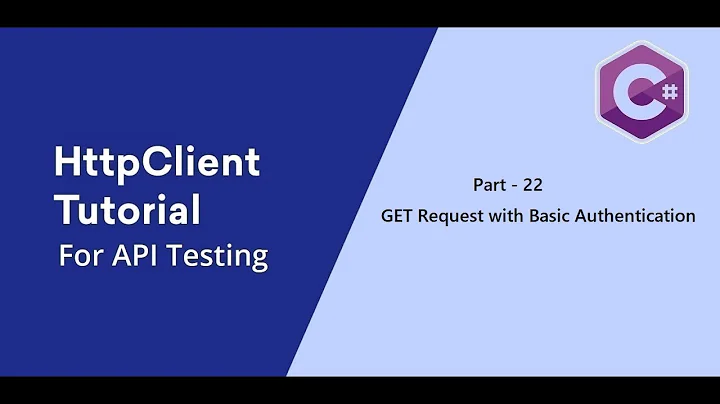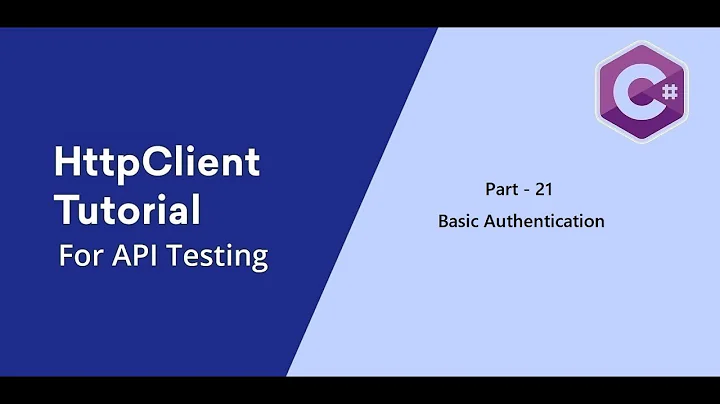Apache HttpClient (4.1 and newer): how to do basic authentication?
Solution 1
We do basic authentication with HttpClient, but we do not use CredentialProvider. Here's the code:
HttpClient client = factory.getHttpClient(); //or any method to get a client instance
Credentials credentials = new UsernamePasswordCredentials(username, password);
client.getState().setCredentials(AuthScope.ANY, credentials);
UPDATE:
A stated in the comments, the HttpClient.getState() methos is available in version 3.x of the API. However, newer versions of the API doesn't support that method.
Solution 2
CredentialsProvider credentialsProvider = new BasicCredentialsProvider();
credentialsProvider.setCredentials(AuthScope.ANY,
new UsernamePasswordCredentials("username", "password"));
CloseableHttpClient httpClient =
HttpClientBuilder.create().setDefaultCredentialsProvider(credentialsProvider).build();
Solution 3
Didn't you download the example from the website?And examples are here: httpcomponents-client-4.1.3\examples\org\apache\http\examples\client
As for https,Just see ClientAuthentication.java:
/*
* ====================================================================
*
* Licensed to the Apache Software Foundation (ASF) under one or more
* contributor license agreements. See the NOTICE file distributed with
* this work for additional information regarding copyright ownership.
* The ASF licenses this file to You under the Apache License, Version 2.0
* (the "License"); you may not use this file except in compliance with
* the License. You may obtain a copy of the License at
*
* http://www.apache.org/licenses/LICENSE-2.0
*
* Unless required by applicable law or agreed to in writing, software
* distributed under the License is distributed on an "AS IS" BASIS,
* WITHOUT WARRANTIES OR CONDITIONS OF ANY KIND, either express or implied.
* See the License for the specific language governing permissions and
* limitations under the License.
* ====================================================================
*
* This software consists of voluntary contributions made by many
* individuals on behalf of the Apache Software Foundation. For more
* information on the Apache Software Foundation, please see
* <http://www.apache.org/>.
*/
package org.apache.http.examples.client;
import org.apache.http.HttpEntity;
import org.apache.http.HttpResponse;
import org.apache.http.auth.AuthScope;
import org.apache.http.auth.UsernamePasswordCredentials;
import org.apache.http.client.methods.HttpGet;
import org.apache.http.impl.client.DefaultHttpClient;
import org.apache.http.util.EntityUtils;
/**
* A simple example that uses HttpClient to execute an HTTP request against
* a target site that requires user authentication.
*/
public class ClientAuthentication {
public static void main(String[] args) throws Exception {
DefaultHttpClient httpclient = new DefaultHttpClient();
try {
httpclient.getCredentialsProvider().setCredentials(
new AuthScope("localhost", 443),
new UsernamePasswordCredentials("username", "password"));
HttpGet httpget = new HttpGet("https://localhost/protected");
System.out.println("executing request" + httpget.getRequestLine());
HttpResponse response = httpclient.execute(httpget);
HttpEntity entity = response.getEntity();
System.out.println("----------------------------------------");
System.out.println(response.getStatusLine());
if (entity != null) {
System.out.println("Response content length: " + entity.getContentLength());
}
EntityUtils.consume(entity);
} finally {
// When HttpClient instance is no longer needed,
// shut down the connection manager to ensure
// immediate deallocation of all system resources
httpclient.getConnectionManager().shutdown();
}
}
}
So in short :
DefaultHttpClient httpclient = new DefaultHttpClient();
httpclient.getCredentialsProvider().setCredentials(
new AuthScope("localhost", 443),
new UsernamePasswordCredentials("username", "password"));
Solution 4
Another modern option for 4.3 is to use the Fluent extension:
Executor executor = Executor.newInstance()
.auth(new HttpHost("somehost"), "username", "password")
.auth(new HttpHost("securehost", 443, "https"), "username", "password") // https example
.auth(new HttpHost("myproxy", 8080), "username", "password")
.authPreemptive(new HttpHost("myproxy", 8080));
String content = executor.execute(Request.Get("http://somehost/"))
.returnContent().asString();
Solution 5
DefaultHttpClient has getCredentialsProvider() but HttpClient doesn't. You need to declare DefaultHttpClient client = ... instead of HttpClient client = ...
Related videos on Youtube
Pablo
Updated on January 05, 2020Comments
-
Pablo over 4 years
How do I add basic authentication for the default client of the httpClient library? I have seen examples where they use
client.getCredentialProvider(), however I think all of this methods are for library version 4.0.1 or 3.x. Is there a new example of how to do this? Thanks a lot.-
ok2c about 12 years
-
Erich about 9 yearsThis is the best example I've found anywhere... way better than the apache documentation : stackoverflow.com/a/4328694/967980
-
-
Spanky Quigman over 11 yearsThat's great, but HttpClient.getState() doesn't exist in the 4.x code. This is only applicable for 3.1 and earlier.
-
 artbristol about 10 yearsThis is the best answer for v4.3. Just be careful that it will send the credentials preemptively to all URLs.
artbristol about 10 yearsThis is the best answer for v4.3. Just be careful that it will send the credentials preemptively to all URLs. -
 artbristol about 10 years
artbristol about 10 yearsDefaultHttpClientis now deprecated in 4.3, despite only being introduced in 4.0! -
Xdg over 9 yearsDefaultHttpClient is deprecated in 4.x. You can use an example hc.apache.org/httpcomponents-client-ga/httpclient/examples/org/… from hc.apache.org/httpcomponents-client-ga/examples.html .
-
Barett over 9 yearsTo solve for artbristol's concern, change the AuthScope.
-
Olivier about 8 yearsHaving struggle a bit to make this work on an https connection, one need no to forget to add port and scheme on HttpHost (new HttpHost("somehost", 443, "https"), as default port and scheme are 80, http.
-
Marco Altieri almost 8 yearsDefaultHttpClient has been deprecated only in 4.3. It is not deprecated in 4.1
-
 Kartik Chugh over 7 yearsAm I the only one confused as to why this is the accepted answer?
Kartik Chugh over 7 yearsAm I the only one confused as to why this is the accepted answer? -
Robert Reiz almost 7 yearsWhat is the full import path for
Executer? I'm getting an error for.newInstance(). Compiler says that doesn't exist. Which version of JDK are you using? -
Barett almost 7 years
org.apache.http.client.fluent.Executorhc.apache.org/httpcomponents-client-ga/fluent-hc/apidocs/org/… -
bmaupin about 4 years@artbristol Only if you have preemptive auth configured, right? "HttpClient does not support preemptive authentication out of the box"
-
 artbristol about 4 years@bmaupin yes I think you're right. This will send the credentials to any server that demands them, but not otherwise.
artbristol about 4 years@bmaupin yes I think you're right. This will send the credentials to any server that demands them, but not otherwise.








